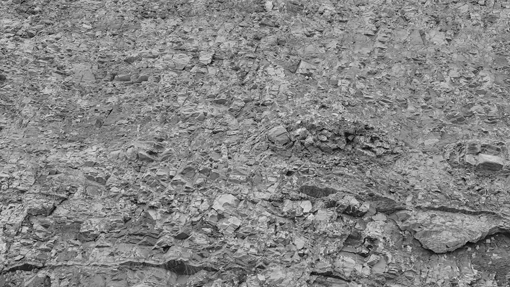Looping film installation developed from a residency on Fur Island, Denmark as part of geological research project Ashlantic.

[Film clip]
Remnants of the opening of the North Atlantic
The island of Fur is a small and secluded island in Denmark. 15,000 years ago, the huge ice sheet that covered Scandinavia and parts of the British Isles pushed some of the sediments in the North Sea into folds in front of the ice. Now that the ice is gone, the folded sediments remain. These particular sediments are very interesting to a geologist, as they accumulated at a very important period in Earth history. Around 56 million years ago, about 10 million years after the extinction of the dinosaurs, the Earth was hotter than it is today. Suddenly, global temperatures increased really quickly. Temperatures rose 5-6 °C worldwide in as little as 2,000 years (which is rapid in geological terms), and stayed hot for up to 200,000 years. In many ways this climate change event, known as the Palaeocene-Eocene Thermal Maximum (or PETM for short), is one of the best natural analogues we have for understanding how human activities cause climate change now and in the future. It is also important in evolutionary terms, as modern mammals only began to dominate ecosystems after this event.
The sediments on Fur island show that the temperatures were really high and that this warming was driven by a huge release of CO2 to the atmosphere. What we’re not sure of is where all this CO2 came from. One possibility is the break-up of the North Atlantic Ocean. 56 million years ago, Greenland was still attached to northwest Europe. As the plates began to move away, enormous volcanoes appeared in the rift between the plates. It is still possible to see remnants of these volcanoes, such as Glen Coe in Scotland and Giants Causeway in Ireland. Volcanoes emit CO2, but in this case the rising magma also heated sediments full of oil and gas as it moved up through the crust. The combined emissions could be responsible for releasing the carbon that caused the severe global warming event.
Fur island is a precious study area because it also contains evidence of these volcanoes. Each black band you see in this video is a volcanic ash layer. The cliff face has over 180 ash layers in total, each one representing an eruption bigger than any we have ever seen in recorded history. Having both the evidence of volcanic eruptions and the sediments showing the temperature changes is especially important for understanding whether there is a link between the two. Were the volcanoes active all the time, especially at the point when warming began, or is there no correlation? Hopefully we will be able to answer these questions soon.
If you would like to know more, please follow us on Instagram: @ceed_ashlantic
Dr. Morgan Jones & Ella Stokke
University of Oslo
Dig site, Fur Island, Denmark 2017